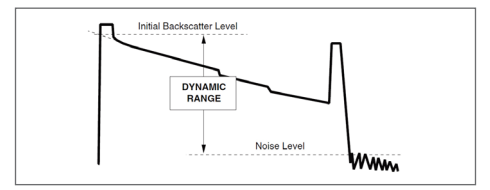
Increasing the total pulse output power of a laser source can be accomplished in two ways: increase the absolute amount of light emitted, or increase the pulse duration (pulse width). There are limits to each of these procedures:
A laser diode has a natural maximum output level that cannot be exceeded. Also, a higher output level means a shorter component life — the laser might burn out faster.
When the pulse width is increased other performance characteristics, such as the dead zone, are affected: longer pulse widths produce longer dead zones.
Sensors also have natural limitations to their ability to measure low light levels. At some point, the electrical level sent out by the sensor (which corresponds to the optical power level detected) becomes lost in the electrical noise of the circuitry and the controller cannot distinguish between the noise and sensor measurements. Electrical shieldingwithin an OTDR is critical in order to decrease the adverse effects of ambient electrical noise in the instrument. Additionally, when a sensor is operating at its peak sensitivity, its level accuracy is decreased. To improve accuracy at lower light levels an OTDR will use averagingtechniques to combine the measurements from thousands of pulses. The use of averaging will improve the sensitivity of a sensor and can therefore improve an OTDR’s dynamic range.
There are several different methods to calculate Dynamic Range. The method above describes the “98% Noise Level” method recommended by many standards organizations. It describes the point at which the backscatter level just starts to get mixed up with the noise level of the instrument. Another common method is called “SNR=1” (Signal-To-Noise Ratio), which is similar to the 98% method, but produces a Dynamic Range value of about 2 dB more. The SNR=1 method indicates the point at which the backscatter level of the trace is lower down into the instrument’s internal noise level. This means you might not be able to clearly distinguish details in the trace at the end of the fiber. A third method is the “Fresnel Detection,” which can add 10 or more dB to the Dynamic Range value. Fresnel Detection measures the point at which the peak of a Fresnel reflection at the end of the fiber can be detected just above the noise level. While this method produces the highest value, it is misleading because it does not relate to how the OTDR is employed for normal use.